
|
Since 1993 Red Sox Nation has known to point their compass towards Fort Myers to begin their season long addiction to the team and sport they love.
Filled with blue plastic seats and surrounded by palm trees, City of Palms Park bears little resemblance to Fenway Park. It doesn't have quirky field dimensions, celebrated foul poles or a monster of a left field wall, but the downtown Fort Myers stadium is just like the iconic Boston bandbox in one regard, as Red Sox fans flock to each in numbers that ensure game day tickets are rarely available. Although its present sell out streak is much more modest than Fenway's due to the limited number of annual Grapefruit League games, at 2009 season's end 88 straight such exhibitions had been sold out at City of Palms Park, which can hold a little over 8,000 folks when all standing room spaces have been gobbled up. Standing room only (SRO) tickets are often all that remain in the weeks that lead up to each game. Although the ballpark's code of conduct specifically states "it is illegal for individuals to offer tickets for resale to the public," scalpers are usually the only option for fans come game day, when their business is a profitable one. I know, as I paid three times face value to not have a seat in 2009, spending $30 for a standing room ticket. The lesson learned is that City of Palms Park is a place where you need to buy your tickets in advance. No other ballpark in the Cactus or Grapefruit League is harder to get into without one on the day of the game. The one benefit to wandering the grounds in search of a ticket is that it allows fans to admire the lush landscaping and ubiquitous palm trees that define the ballpark's picturesque exterior.
Although the exterior scenery is a hard act to follow, City of Palms Park also packs some pizzazz within its walls. The main concourse is behind the grandstand, which has just two entrance portals and zig-zag handicap ramps at its ends. Upon ascending either stairs or the ramps, fans enter a wide aisle from which many initial gazes will focus on the palm trees that serve as the backdrop in the outfield. Those sitting above the aisle will most likely be under cover thanks to the cable supported roof that spans most of the 200-level seating sections, which are sold as reserved seats. Box seats make up the 100-level sections of the park, all of which are below the interior aisle and not under the roof. Their lack of cover explains why the paint on them has faded over the years. All seats were installed prior to cup holders being considering a necessity, and none have been added to them since. Over the years the park has expanded with the addition of a pair of seating sections. First came bleachers down the right field line, then in 2007 a right field deck was built behind the outfield fence. The bleachers are behind a small but lengthy berm and don't have seatbacks of any sorts. The deck has three rows of fixed barstools set up along drink rails. The 150 seats there were patterned after the Green Monster seats at Fenway. The facade of the right field deck also takes another cue from Fenway as numbers retired by the Red Sox are on it. The facade of the press box is affixed with logos of all 30 teams, not just those in the American or Grapefruit League. Pennant-style banners listing the seven years that the Red Sox won the World Series adorn the facade of the batting cage building down the left field line. Near it are picnic tables set up exclusively for team personal. Beyond them is a pregame party tent that can be reserved by groups of regular, but probably well-heeled, fans. Likewise, a select group of fans are allowed on the playing field to watch the Red Sox take batting practice. Ballpark gates open early enough - 2½ hours before game time - that all early birds can watch the majority of the Olde Towne Team's BP. Autograph seekers congregate in the dugout box seat sections, which are actually slightly below field level and serve as the official "autograph alley" up until 15 minutes before game time, when two rows of folding chairs are set up for even more well-heeled fans. But these premium seats are a lousy buy. Fans in dugout box seats may be close to the field, but the vantage point is horrible. The two rows of fixed home plate box seats, which are between the dugouts, are a much better option for those willing to spend big bucks. It's easy to burn through bucks in pursuit of Red Sox paraphernalia at the team's gift shops, which are stocked with a wide selection of hats and clothing. The main team store is air-conditioned and simply called the Red Sox Baseball Store. It's located on the third base concourse. The Home Plate Merchandise shop is named after its location. Although also built into the exterior wall of the concourse, it's of the open-air variety and can't block out the humidity. Concessions are crappy and not particularly cheap. It's too bad on both fronts that vendors aren't set up out front selling sausages and the like. Once upon a time the Boston Globe was sold outside of the main entrance, but that practice was discontinued once the digital age of news delivery became firmly entrenched. The stadium's sole scoreboard in left-center field harkens back to the old days. It has a monochrome message board that flashes announcements between innings and an all-around weathered look. The most popular songs played over the stadium's loudspeakers are also from a different era, but are much anticipated. Sweet Caroline is played in the middle of the 8th inning and Dirty Water immediately follows Red Sox wins. Both songs are Fenway traditions. Many of the same companies who advertise at Fenway do so at City of Palms Park, where the outfield walls are filled with ads touting products and services available back in New England. Hence the billboards for Giant Glass and the 99 Restaurant chain. The bullpens are behind the ad covered walls. Their locations are noticeable only because elevated bleachers covered by a red awning are next to each. The Red Sox bullpen is close to the left field foul pole, while the visitors' is between the hitter's backdrop and right field deck. Although fans can't watch pitchers warming up, they can see them watching the game from their lofty and shaded perch.
The majority of fans that gain admission via a standing room only ticket line the back wall of the grandstand's aisle, where they are shaded by the ballpark's roof. Since reserved seating sections are elevated about 6½ feet above the aisle fans standing along its blue wall will not obstruct anyone's view. Aside from a limited number of suites, no part of the ballpark is off limit to fans. Ushers do monitor the walkway between the berm and bleachers down the right field line. A barricade there prevents fans from walking through the area during the game, which would be a nuisance to those seated in the bottom rows of the three unmarked bleacher sections. The barricade is simply an elastic band attached to two stands, similar to the crowd control barriers set up at movie theatre box offices. The City of Palms Park box office is rarely needed outside of spring training, as the Red Sox are the ballpark's only permanent baseball tenant. The only other professional team to use the stadium since it opened is Boston's rookie team in the Gulf Coast League, but since 2005 they have played all of their games at the team's minor league complex, which is 2½ miles east, a fact that doesn't sit well with the Red Sox's top brass, who would prefer all of their operations be contained at one site. The Red Sox do have a single practice field behind left field at City of Palms Park, but their other five practice fields are at the Player Development Complex. As nice as City of Palms Park is, and pleasant may be the most apt description, its biggest flaw is that it was built about five years before many of the amenities that are commonplace became standard issue, which makes the ballpark feel more dated than it actually is. That partially explains why the Red Sox were prepared to exercise an out clause in their lease after the 2011 season. But after flirting with Sarasota, the team in late 2008 agreed to stay in Fort Myers for the long haul, just not at City of Palms Park. In 2012 the Sox will move into a new ballpark about 10 miles to the southeast and you can bet the new place will have an open concourse, seats with cup holders, a scoreboard with video, luxury boxes aplenty and a half dozen practice fields adjacent to it. Those are all things City of Palms Park lacks. That doesn't make it a bad place, just not state-of-the-art and for a team like the Red Sox only the best will do, for the organization and their fans. So as the saying goes, the best is yet to come. When it does, Red Sox Nation will point their compass just a little bit further south and City of Palms Park will contain nothing but two decades of memories for the legions who flock to Fort Myers each spring.
Location and ParkingCity of Palms Park is tucked away in a residential neighborhood that's one mile from downtown Fort Myers and 4½ miles west of I-75. Besides palms trees, the stadium is surrounded by small single story homes and two story apartment complexes. Aside from the ballpark, it's not an area the Chamber of Commerce would promote. Grass fields on opposite sides of the stadium provide spaces for up to 1,500 cars but they fill up before game time, which provides an opportunity for nearby homeowners and non-profits to earn some extra money. The Salvation Army and Central United Methodist Church join a handful of neighborhood residents in offering parking for a donation or fee to those shut out of the two official lots.
Ballpark History and FutureCity of Palms Park had two missions when it was built by the City of Fort Myers. The obvious one was to become the new Spring Training home of the Boston Red Sox, which the team and city agreed would be the case on December 5, 1991. Secondly, the city hoped to revitalize a blighted neighborhood near downtown by building a ballpark as part of a redevelopment plan, a trend that in the early 1990s had been successfully implemented on the Major League level in Baltimore and Cleveland. To do so in Fort Myers, about three square blocks of privately held land was pried from its collective owners via eminent domain. The 26-acre land grab was needed for the stadium, which initially sat 6,990, and its parking lots. To spruce the place up further, 250 palm trees were planted around the stadium, which estimates at the time reported to cost $21.9 million or $24 million, depending on the source. The city, naturally, claimed the lower number to be valid, as taxpayers footed the bill for the project. Designed by HOK Sport, the second spring training ballpark to open in two years in Fort Myers (following Hammond Stadium) did so on March 5, 1993 when the Red Sox christened City of Palms Park by beating Boston College 2-0 before 6,115 fans, the first of many capacity or near capacity crowds in the stadiumís history. Although City of Palms Park has been successful in luring baseball fans to its grounds, it never brought the revitalization that was hoped for in the community. The neighborhood is still noted for its low income dwellings and has but two points of pride, the Fort Myers Skatium ice rink and Yawkey Park, a playground adjacent to the parking lot behind right field. Only the ice rink brings people into the area. The playground is for the residents who werenít displaced by the ballparkís construction, which required over 100 buildings to be razed. Although the city was responsible for building City of Palms Park, the debt it occurred in the process led them to relinquish control of it in 2004, at which time Lee County assumed ownership of the stadium and minor league facility, both of which are on Edison Avenue but 2½ miles apart. Fort Myers is the county seat of Lee County. Heading into 2009, Fort Myers still owed millions in stadium debt, $26,560,401 to be precise. That total reflects both principal and interest and is more than the original construction cost of City of Palms Park itself. How is that possible? The city paid mostly interest on their 30-year bond debt for the stadium during its first 15 years of life. The deal with Lee County shed them of annual maintenance costs, which the county now lists at $1.26 million, but didnít include any aid to ease the cityís stadium debt. When Lee County took over operations they did so under the condition that the Red Sox extend their lease, which would bind them to City of Palms Park through 2019, and contribute $300,000 per year in rent along with another $20,000 designated for capital improvements. To sweeten the deal, Lee County agreed to spend $1.5 million in 2004 on capital improvements, which included repainting the stadium and repairing its leaks and electrical system.
That buyout came into play in 2008, when the Red Sox were being wooed by Sarasota with promises of a new ballpark and enhanced training facility for their minor leaguers. Faced with losing the Red Sox following 2011 spring training, Lee County commissioners stepped up to the plate on October 28, 2008 and voted in favor of building a new complex, estimated to cost in the neighborhood of $80 million, for the team in the southern part of the county, close to the Southwest Florida International Airport. The Red Sox responded by agreeing to a 30-year lease approved by the countyís five member Board of Commissioners on December 9, 2008. That lease contains no buyout clause and increases the rent the team will pay to $500,000 per year, which will be raised 3 percent every five years. The team and county also agreed to each put $37,500 annually into a fund to be used for stadium maintenance. While the new deal keeps the Red Sox in Fort Myers, or technically an unincorporated area just south of city limits, it puts the future of City of Palms Park very much in doubt when the Sox move out. The 2011 spring season will be their final one there. With just about every team locked up for years to come, only the Baltimore Orioles are in need of a new Florida-based spring training locale. The Orioles have trained in Fort Lauderdale since 1996 but are essentially being kicked out of their stadium by the FAA, which owns the land Fort Lauderdale Stadium sits on. The Orioles list of suitors is two -- Sarasota, which was unsuccessful in its pursuit of the Red Sox, and Fort Myers, which has a stadium to spare thanks to their reaction to Sarasotaís overtures for the Red Sox. But a new stadium wonít be a part of either cityís offer. The Orioles will either choose a renovated version of Ed Smith Stadium, which the Reds abandoned in 2009, or City of Palms Park. If they opt for the former then the latter will become an unused debt ridden nightmare for Fort Myers, rather than the field of dreams it was intended to be.
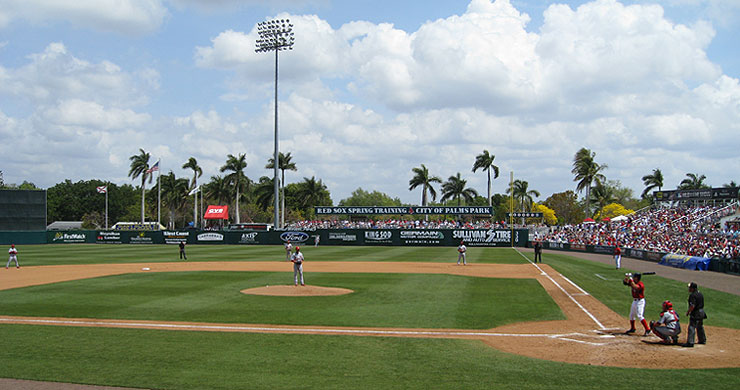
City of Palms Park Facts, Figures & Footnotes
| ||||||||||||||||||||||



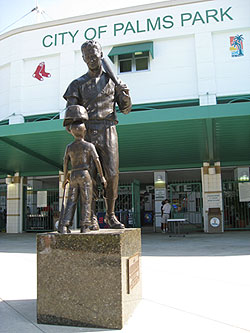 The palm tree-lined avenues (Edison and Broadway) that run parallel to the first and third baselines have their own entrances. At their intersection behind home plate is the stadium's main entrance, which has a sizable open plaza outside of its numerous gates. A statue of Ted Williams was erected in the middle of the plaza in February 2007 and has been a popular landmark for pregame snapshots ever since. The Splendid Splinter's Hall of Fame acceptance speech and career accomplishments are etched into stone tablets that rest against the stadium on opposite ends of the plaza.
The palm tree-lined avenues (Edison and Broadway) that run parallel to the first and third baselines have their own entrances. At their intersection behind home plate is the stadium's main entrance, which has a sizable open plaza outside of its numerous gates. A statue of Ted Williams was erected in the middle of the plaza in February 2007 and has been a popular landmark for pregame snapshots ever since. The Splendid Splinter's Hall of Fame acceptance speech and career accomplishments are etched into stone tablets that rest against the stadium on opposite ends of the plaza.
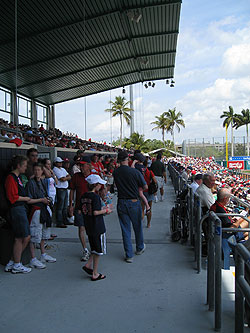 A patio above the third base grandstand allows fans their own elevated viewpoint. Those standing there can take advantage of the drink rails that are set up behind the last row of seats, while picnic tables and food carts are also found in the first-come, first-served area.
A patio above the third base grandstand allows fans their own elevated viewpoint. Those standing there can take advantage of the drink rails that are set up behind the last row of seats, while picnic tables and food carts are also found in the first-come, first-served area.
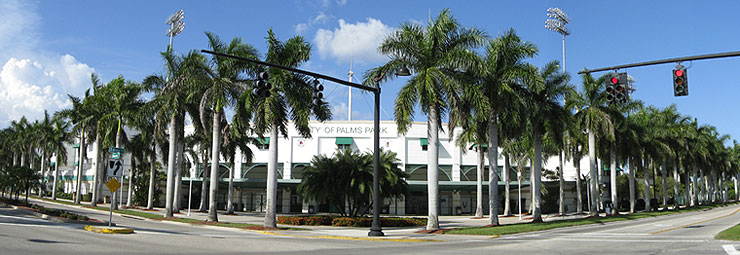
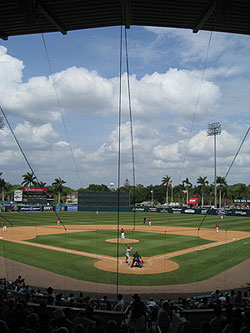 What the county didnít force the Red Sox to do was to agree to an ironclad lease. Instead, it included an escape clause that would allow the team to leave by paying a relatively paltry penalty, which would top out at $1 million.
What the county didnít force the Red Sox to do was to agree to an ironclad lease. Instead, it included an escape clause that would allow the team to leave by paying a relatively paltry penalty, which would top out at $1 million.
